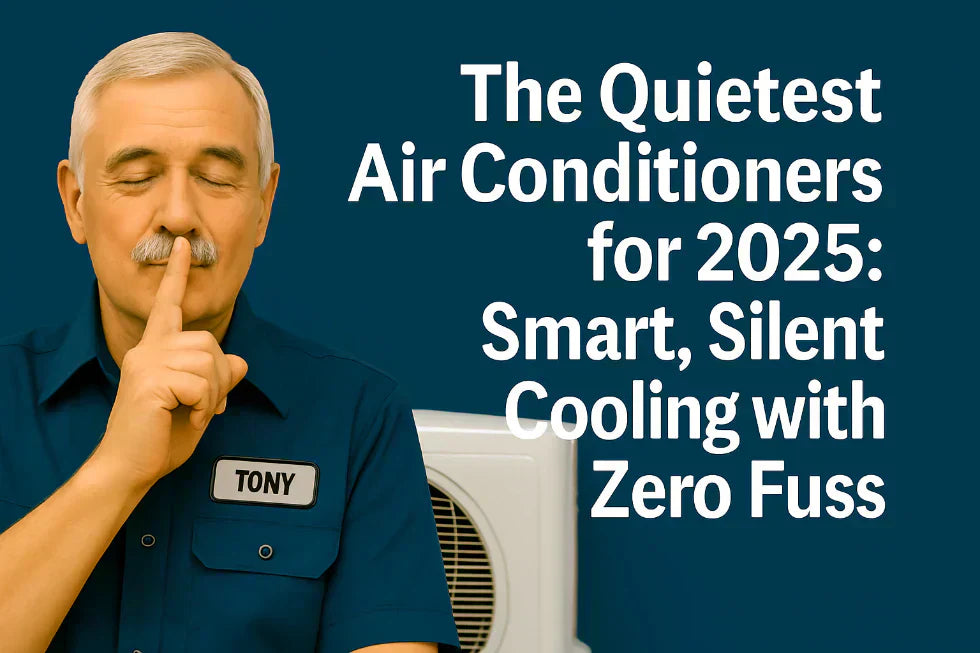👋 Hey Folks! Tony your Trusted Tech here. Today we're talking about finding the perfect quiet air conditioner—whether you're searching for the quietest window air conditioner, a silent AC for your bedroom, or the top energy-efficient window unit AC for a small space. We’ll dive deep into noise levels, efficiency, and features that matter, while sprinkling in pro tips and trusted resources. And if you ever decide to upgrade to full-home cooling, don’t miss our comprehensive guide: The Complete Guide to a 2.5‑Ton Air Conditioner – Smart Cooling for Smart Homes.
🔊 What Does Quiet Even Mean? (Decibels & All That)
When evaluating air conditioner quiet window units or ultra quiet air conditioners, it's all about sound levels, measured in decibels (dB). Most folks can't hear under 45 dB, so that's a good baseline, but whisper-quiet models hit 30–40 dB—perfect for bedrooms.
📊 A helpful resource on ambient sound levels comes from the U.S. Environmental Protection Agency (EPA)—they categorize indoor noise:
-
30 dB = whisper
-
40 dB = library
-
50 dB = light traffic
For the most silent window AC, choose one rated closer to 40 dB so it hums quietly behind your dreams—not disrupts them.
🧩 Window vs. U Air Conditioner vs. Small Units
Trying to find the quietest small window air conditioner or a sleek U-shaped unit that works well in bedrooms, dorms, or small home offices? These compact models deliver surprisingly powerful cooling—typically between 6,000 and 12,000 BTUs—and keep the noise down while keeping you cool. 💤❄️
But picking the right BTU size is just as important as the noise level. Oversize your unit and you'll waste energy; undersize it and you'll end up with lukewarm air. That’s why the Better Homes & Gardens AC sizing guide is such a helpful tool—it walks you through square footage, sun exposure, and ceiling height to choose just the right capacity for your room: Check out the full guide here. 📏
And when energy efficiency is a top priority (which it should be!), look for ENERGY STAR® certified room air conditioners. These units use less energy, cost less to run, and often come with quieter, variable-speed compressors. You can browse top-rated models here: ENERGY STAR Certified Room ACs. ⚡🌿
⚖️ Balancing Cost, Noise & Efficiency
Let’s do a quick tradeoff table in words:
-
Entry-level (under $400): Basic noise, 45–50 dB
-
Mid-range ($500–700): ENERGY STAR certified, 42–45 dB, inverter fan
-
Premium quiet ($800+): 12k BTU, 35–42 dB, insulated frame, Wi-Fi, sleep sound control
If noise is critical, it pays to invest a bit more—but for many bedrooms, a mid-range ENERGY STAR unit hits the balance between calm comfort and smart value.
🔧 Maintenance for Long-Term Quiet
Keep your system whisper-soft with:
-
Monthly filter cleaning
-
Annual condensate pan checks to avoid overflow noise
-
Inspect exterior panels after storms—loose screws = vibration
-
Clear outside vents to ensure airflow efficiency and reduce strain/noise
The ACCA guidelines already mentioned are excellent for seasonal service checkups and troubleshooting.
🏠 When to Upgrade to Dual-Hose or Central AC
If you've hit the limits of even the quietest window AC unit or your setup keeps getting louder, it may be time to consider a dual-hose portable AC—or go full central AC—for greater efficiency and near-silent operation.
Need help comparing options? The U.S. Department of Energy's page on Central Air Conditioning covers everything from sizing and efficiency to installation best practices, making it easy to compare dual-hose, central, and mini-split systems: DOE Central Air Conditioning Guide.
These systems often run with sound levels below 50 dB—and some even dip under 45 dB in night mode—making them an excellent choice when quiet comfort and whole-home cooling are top priorities.
💭 Final Thoughts from Tony
When you're hunting for the quietest window AC unit, remember—low noise is just one part of the equation. You also want the right size, strong energy efficiency, and a clean install to really keep your space cool and peaceful.
Shoot for an ENERGY STAR–certified unit in the 8,000–12,000 BTU range. Use noise-reducing tips like foam window seals or vibration pads, and don’t hesitate to invest a little extra for a unit that won’t keep you up at night.
And hey—if you ever feel like your space is outgrowing that window unit, you might be ready to explore something more powerful. I break it all down in this guide to 2.5-ton air conditioners—it’s a solid read for understanding when to level up without sacrificing quiet comfort.
🛠️ When it comes to comfort, I’ve got your back. Keep it cool
— Tony 🛠️







